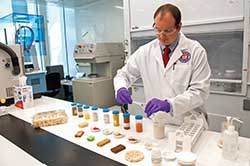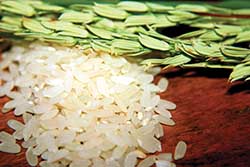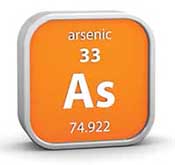Arsenic and Old Rice
FOOD SAFETY & QUALITY
 Arsenic is well-known for its intentional use as a poison. Fans of the 1944 comedy film Arsenic and Old Lace may remember that the Brewster sisters used it in their homemade elderberry wine to murder lonely old men. But arsenic also occurs naturally in various foods, such as rice, because it is found naturally in the environment. Arsenic is an odorless and tasteless element that enters water and crops from natural deposits in the earth as well as from agricultural and industrial practices, including use of arsenical pesticides/herbicides (most of which are no longer in use), fertilizers, irrigation, burning of fossil fuels, and disposal of industrial and animal waste. It is a known carcinogen and causes other health problems. The U.S. Environmental Protection Agency (EPA) has set a limit of 10 ppb for arsenic in drinking water to protect consumers from the effects of long-term, chronic exposure to arsenic. The U.S. Food and Drug Administration (FDA) has the same standard for bottled water but has set no limit for arsenic in foods.
Arsenic is well-known for its intentional use as a poison. Fans of the 1944 comedy film Arsenic and Old Lace may remember that the Brewster sisters used it in their homemade elderberry wine to murder lonely old men. But arsenic also occurs naturally in various foods, such as rice, because it is found naturally in the environment. Arsenic is an odorless and tasteless element that enters water and crops from natural deposits in the earth as well as from agricultural and industrial practices, including use of arsenical pesticides/herbicides (most of which are no longer in use), fertilizers, irrigation, burning of fossil fuels, and disposal of industrial and animal waste. It is a known carcinogen and causes other health problems. The U.S. Environmental Protection Agency (EPA) has set a limit of 10 ppb for arsenic in drinking water to protect consumers from the effects of long-term, chronic exposure to arsenic. The U.S. Food and Drug Administration (FDA) has the same standard for bottled water but has set no limit for arsenic in foods.
Rice, a staple crop grown around the world, is the second-highest source of arsenic in the American diet (seafood is the highest). According to Steve Hensley, Senior Director of Regulatory Affairs, USA Rice Federation, rice is the single crop that has the highest average arsenic content (although vegetables as a group contribute more arsenic). Arsenic is absorbed from soil or water and concentrated in the outer layers of rice as it grows. Since white rice is produced by removing the surface layers, it tends to have lower arsenic levels on average than brown rice, of which only the hull is removed.
Hensley said that the United States produces 2% of the world’s annual rice supply but is the world’s third-largest exporter of rice, sending 50% of annual production to overseas customers. Eighty-five percent of the rice consumed in the United States is grown in the United States. Rice farmers in Arkansas, California, Louisiana, Mississippi, Missouri, and Texas produce more than 20 billion pounds of rice each year, including long-, medium-, and short-grain types as well as aromatic and specialty types.
Arsenic Levels Surveyed
Various organizations have surveyed the levels of arsenic in rice and other foods. Consumers Union reported in its November 2012 issue of Consumer Reports that its tests showed that rice products on grocery shelves contain arsenic, many at worrisome levels, and recommended that consumers consider limiting their consumption of rice products.
The FDA has been measuring arsenic in food commodities for more than 20 years through its Total Diet Study (TDS), according to Nega Beru, Director of the FDA’s Office of Food Safety. Arsenic occurs in both organic and inorganic forms, with the organic considered much less harmful than the inorganic forms, but the TDS analyzed products for only total arsenic content. Beginning in 2011, he said, the agency began sampling and analyzing rice and rice products for total arsenic content as well as organic and inorganic contents and posted the results for about 200 samples in September 2012. The agency then performed additional sampling and testing, and in September 2013 the agency posted the results for approximately 1,300 samples of rice and rice products. The FDA concluded that the amount of detectable arsenic was too low in the rice and rice product samples to cause any immediate or short-term adverse health effects and recommended that consumers eat a well-balanced diet for good nutrition and to minimize potential adverse consequences from consuming an excess of any one food. The FDA said that it has seen no evidence of change in levels of total arsenic in foods over the more than 20 years of the TDS.
Since technology is now available that provides greater specificity about the different types of arsenic present in foods, Beru said, the agency’s next step is to use these new tools to consider long-term exposure to very low amounts of arsenic in rice and rice products. He said that the agency is working to assess the potential health risk from long-term exposure to the arsenic in rice and rice products and to determine how much arsenic is consumed from rice and rice products and whether health effects differ among segments of the population. FDA scientists at the Center for Food Safety and Applied Nutrition, in consultation with colleagues in the FDA’s National Center for Toxicological Research, the National Institute of Environmental Health Sciences, and the EPA are conducting a risk assessment. Toxicologists will be looking at the data on possible different adverse effects from arsenic exposure in rice, nutritionists will be studying rice consumption patterns, and epidemiologists will be looking for patterns of disease. At the same time, Beru said, the rice industry, university researchers, and the U.S. Dept. of Agriculture will be working to identify ways to possibly reduce arsenic levels in rice during production.
--- PAGE BREAK ---
In November 2013 the Canadian Food Inspection Agency released the results of a survey conducted as part of its routine testing of various food products and said that all samples of rice and rice products, breakfast and infant cereals, fruit products, bottled waters, and seaweed products analyzed for arsenic were safe for consumption. The agency analyzed 1,071 food samples, including 280 rice and rice products, to determine the total arsenic content and the levels of various organic and inorganic species present. The study, conducted during 2010–2011, found that 96.5% of all the samples tested contained detectable levels of total arsenic. The current regulatory tolerance in Canada for arsenic in fruit juice, fruit nectar beverages, and ready-to-serve water in sealed containers other than spring or mineral water is 100 ppb and is under review by Health Canada.
Setting Limits
The Codex Alimentarius Commission has been addressing the issue of arsenic in foods to meet the need for an internationally harmonized regulatory level based on scientific evidence that would protect human health with a minimum of economic impact on international trade. Beru said that the Codex Committee on Contaminants in Foods (CCCF) began working on establishing maximum levels for arsenic in rice in March 2011 and in March 2012 considered establishing maximum arsenic levels of 300 ppb for brown rice and 200 ppb for polished rice. Work is on hold, he said, until the group meets again in March 2014, when more data will have been obtained from more countries. In the meantime, a working group of the CCCF is preparing a discussion paper regarding the possibility of establishing a code of practice, a document that lays out measures growers/processors can take to reduce arsenic levels in rice. Among the considerations being discussed by the Codex committee are whether a maximum level for arsenic should be based on total arsenic level, inorganic arsenic level, or a combination of both as well as whether there should be different limits for different arsenic species.
 Arsenic Analysis
Arsenic Analysis
Russell Gerads, CEO/President, Applied Speciation and Consulting LLC, said that interest in arsenic speciation to properly ascertain the true risk of food products has increased significantly in the past decade. There are numerous species of arsenic, he said, including arsenite, arsenate, monomethylarsonic acid, dimethylarsenic acid, trimethylarsine oxide, tetramethylarsonium ion, arsenocholine, arsenobetaine, thio-dimethylarsenite, roxarsone, arsenolipids, arsenosugars, p-arsinilic acid, and phenylarsonic acid. Since the different species have different toxicity, he added, it is important to be able to identify and quantify each of the species. For example, trivalent arsenic and arsenobetaine have different toxicities and metabolic pathways within the human body, so they do not have the same effects. Also, certain extraction methods decompose organic arsenic species to inorganic arsenic, which can produce false positives when assessing the consumption risk for humans. Extraction and analytical methods must be specific to the substrate components and the target arsenic species.
In addition to several preparatory methods for arsenic speciation analysis, he said, there are several analytical methods available for speciation that involve combinations of chromatography, spectroscopy, and mass spectrometry. They include hydride generation/cryogenic trapping/gas chromatography/atomic fluorescence spectroscopy (HG-CT-GC-AFS), ion chromatography/hydride generation/atomic fluorescence spectroscopy (IC-HG-AFS), ion chromatography/inductively coupled plasma/mass spectrometry (IC-ICP-MS), reversed-phase chromatography/inductively coupled plasma/mass spectrometry (RPC-ICP-MS), normal-phase chromatography/inductively coupled plasma/mass spectrometry (NPC-ICP-MS), size-exclusion chromatography/inductively coupled plasma/mass spectrometry (SEC-ICP-MS), and some chromatography options compatible with soft-ionization MS-MS.
Gerads said there are a number of concerns regarding the limitations in the field of metalloid speciation analyses. Most industrial, commercial, and academic laboratories have limited knowledge and experience with the different preparatory and analytical methods pertinent to the field. Since the level of understanding is limited, many scientists will attempt to use older technologies (hydride generation) that exist in their laboratories rather than pursue analytical platforms, which can support greater expansion of understanding and quality. The limitations the scientists place on themselves are propagated into the data and quality objectives of an investigation, which becomes a disservice to the scientific community as a whole, he said.
Among the ways to overcome these limitations, he added, are setting data objectives independent of individual (person or laboratory) knowledge or experience; selecting preparatory methods in accordance with matrix type, detection limits, and target molecules; and selecting analytical methods that can support resolution of arsenic species in extracts. He said that the one-size-fits-all approach has not been found to work and extraction and analytical methods must be specific to target molecules—namely, solvent extractions for nonionic species and water-based extractions for ionic species. Within these extraction subsets are an array of options (e.g., enzymes, alcohols, organic acids, hexane, xylene, etc.), each having different benefits and limitations and applicability to different situations. He said that proper quality control must be employed to monitor species conversion of target and non-target molecules, extraction efficiency, and retention-time confirmation.
--- PAGE BREAK ---
Research Needed
Hensley of the USA Rice Federation said that the rice industry is conducting research to find existing cultivars that accumulate lower levels of arsenic as well as growing techniques that could reduce arsenic uptake. Researching cultivars that naturally accumulate lower levels of arsenic and are adaptable to the various rice-growing regions of the United States, and that are acceptable to the markets and consumers, is an endeavor that may take 10 or more years. It involves testing large numbers of samples to determine the impacts on rice yield, quality, disease resistance, cooking characteristics, and consumer preference as well as water-management techniques.
Other industry research projects underway include toxicological research to examine the mode of action of arsenic in the human body and to prove that it is a threshold effect—that is, below a certain level there is no adverse impact on health—a risk/benefit analysis to quantify the known health and nutritional benefits of rice consumption relative to the perceived risk, and research on water-management techniques that may reduce arsenic uptake. The USA Rice Federation provides information on industry efforts regarding arsenic through the website www.arsenicfacts.usarice.com.
Other research that needs to be done, Hensley said, is determining the range of arsenic levels found in U.S. rice (total, organic, and inorganic); whether commercial lab testing processes are validated to ensure consistent results relative to FDA test methods; how to test, if required, in a way that doesn’t slow or stop the rice supply; and which management practices in production and processing can feasibly be modified to reduce the arsenic content of rice.
 Arsenic in Juices
Arsenic in JuicesConsumers Union reported in the January 2012 issue of Consumer Reports that results of tests it conducted found arsenic in apple and grape juices and urged the FDA to set an arsenic limit of 3 ppb for those products. In 2008 the FDA conducted a hazard evaluation and established a 23 ppb level of concern for inorganic arsenic in apple juice. In 2011 the agency increased its testing and analysis of apple juice and said that that the levels of inorganic arsenic in apple juice were too low to cause immediate or short-term health damage. On July 12, 2013, the agency proposed to establish an action level of 10 ppb for inorganic arsenic in apple juice, which is the same level set by the EPA for arsenic in drinking water. The FDA said that on the basis of its data and analytical work, it was confident in the overall safety of apple juice for children and adults and that it proposed the action level to help prevent public exposure to the occasional lots of apple juice with arsenic levels above those permitted in drinking water.
The FDA said that it has been monitoring the presence of arsenic in apple juice for the past 20 years and has consistently found that samples contain levels of arsenic that are low with few exceptions. New tools, however, have allowed the agency to better understand the breakdown between organic and inorganic arsenic levels. In 2012 the FDA released findings from its latest collection and analysis of 94 samples of apple juice: 95% of the samples were below 10 ppb of total arsenic, and 100% were below 10 ppb of inorganic arsenic. The proposed 10 ppb level took into account those results and a peer-reviewed risk assessment of inorganic arsenic in apple juice conducted by FDA scientists, using data from two studies published in 2010 as well as a 2011 evaluation by the Joint Expert Committee on Food Additives and Contaminants (JECFA) of the Food and Agriculture Organization/World Health Organization.
A 60-day comment period on the proposal and a 60-day extension ended on November 12, 2013, and the FDA is evaluating the comments. The agency also studied pear juice in 2008 and established a level of concern for inorganic arsenic in pear juice of 23 ppb. Sampling for additional fruit juices and foods is being conducted or considered.
 Neil H. Mermelstein, a Fellow of IFT,
Neil H. Mermelstein, a Fellow of IFT,
is Editor Emeritus of Food Technology
[email protected]


